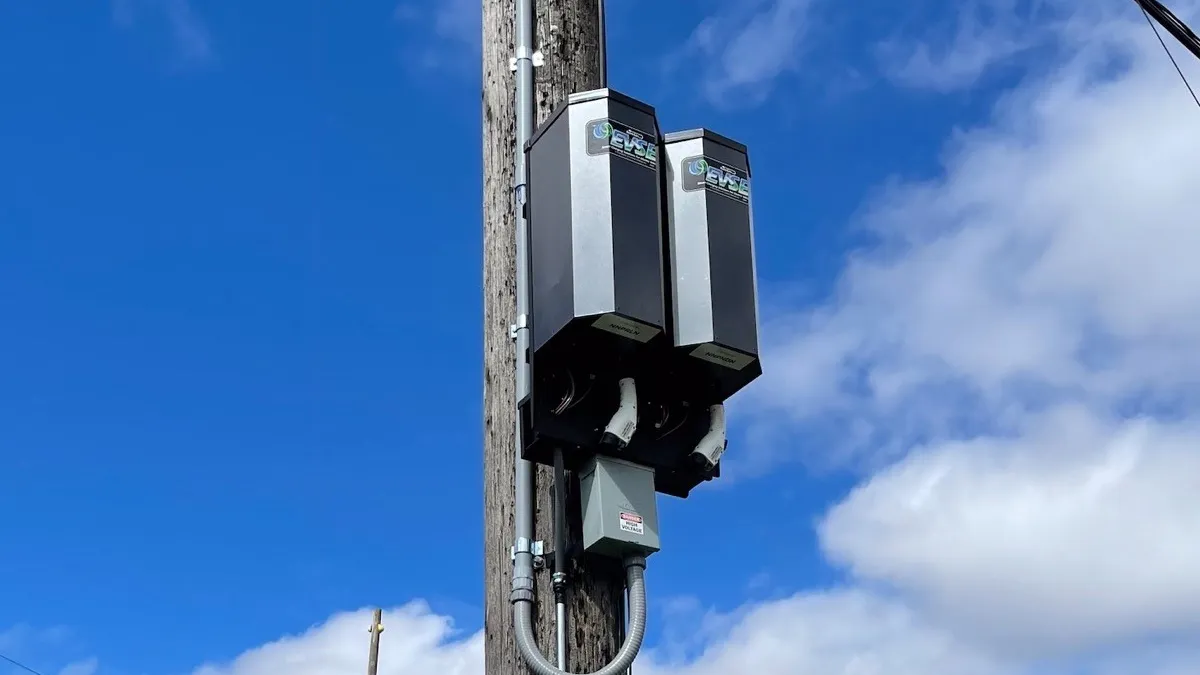Dive Brief:
- Electric utility Seattle City Light has launched a program to install public curbside Level 2 electric vehicle chargers on utility poles or standalone pedestals at 30 locations across the city. The goal is to provide a close-to-home charging option for residents who don’t have access to off-street parking, where most charging occurs.
- Residents living within city limits can request a charger near their home if they own an EV or plan to purchase one within the next year. City Light will install chargers for free at locations that meet eligibility requirements and rank high in the utility’s evaluation process.
- City Light expects to begin charger installations later this year and to finish by early 2023. The utility will do a post-mortem analysis and anticipates additional deployments if the chargers prove to be financially viable and residents consider them valuable, according to Jacob Orenberg, Seattle City Light senior capital projects coordinator.
Dive Insight:
Seattle City Light will install, own, operate and maintain the new chargers. Residents will pay a fee per kilowatt-hour to use the chargers; the fee covers the cost of electricity and system operations, maintenance, and repair while offsetting the initial purchase and installation costs. The 2022 fee is 20 cents per kWh. These chargers can provide the typical EV with more than 30 miles of range per hour of charge time.
Each installation will charge one or two vehicles, depending on the location characteristics, for an estimated total of 45 to 60 chargers, Orenberg said. Installations at each site will cost an estimated $11,000 to $25,000. The 40-amp Level 2 chargers will have a J1772 connector, which is compatible with all EVs on the market in North America.
City Light wants to focus on the most difficult and expensive places to install infrastructure because “if we're tackling those challenging areas, we're reducing barriers across the broader community,” said Angela Song, transportation electrification portfolio manager at City Light.
The U.S. Census Bureau’s 2019 American Housing Survey shows that more than one-third of U.S. homeowners — and nearly two-thirds of renters — do not have a garage or carport. About 80% of Americans’ personal EV charging occurs at home, usually overnight in one of those structures. Consumers consistently cite EV range and anxiety over not having enough of a charge to reach destinations as key barriers to purchasing an electric vehicle.
“More than 50% of our communities are renters, and that lends to living in... multifamily housing,” Song said. “We're really excited and hope this can really push the bounds and increase the adoption of electric vehicles” by increasing those communities’ access to chargers.
Organizers would like to have at least three EV chargers in each of Seattle’s seven council districts to ensure a relatively even geographic distribution throughout the service area, rather than placing them in the one or two districts that currently have the most EV owners, Orenberg said.
The public opt-in process is different from how some other cities conduct public infrastructure installations. Soliciting and incorporating community feedback about charger locations, instead of the utility simply making the decision, is a pillar of the program. This helps to ensure the chargers actually will be used and adds value while better meeting individual communities’ needs, Orenberg said.
“We know our communities really want to have their wants and needs reflected in our programs,” Song said. “We’re hoping to gain from this a holistic viewpoint of where the community wants these charging stations, and that will inform future programs as well.”
As of last week, City Light had received 513 applications. After the application period closes later this summer, City Light will evaluate each proposed location to determine suitability for the new infrastructure and potential community benefits. Each location will be scored, and the top-ranking sites will receive installations.
Seattle City Light will use off-the-shelf charging technology from EVSE designed to be mounted on poles. Beyond that, the utility is developing the program from scratch to meet the unique needs of the Seattle service area, Orenberg said.
“There are very few other utilities and municipalities in the country that are currently pursuing EV charging solutions for the residents,” he said. “We want to provide a service for current EV owners who may be struggling to charge their vehicle, but also [to] prospective EV owners; basically, this might be the thing that would push them to the point where they would buy an EV.”
Last year, a World Resources Institute study about domestic installations of EV chargers on utility and light poles found that only four U.S. cities — Los Angeles and Lancaster, California; Melrose, Massachusetts; and Portland, Oregon — had then undertaken such a project. Last year, Kansas City, Missouri, also launched a program to do so. WRI’s study concluded that little information is available to help cities that want to take this approach to expanding EV charging.
















